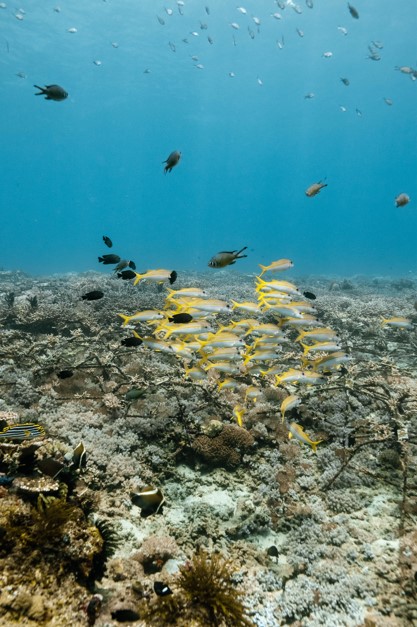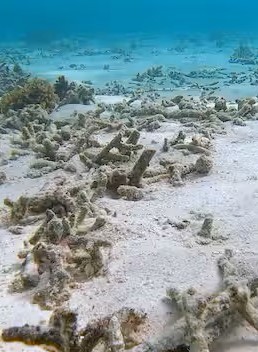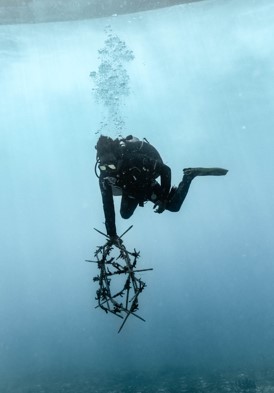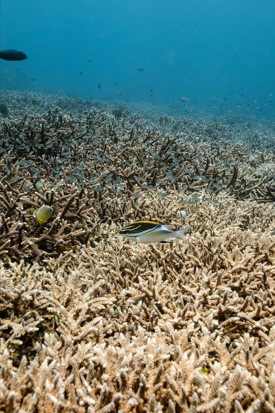
Restoration and conservation
of coral reefs
“We build houses
for fish.”
Coral reefs play a vital role in the marine ecosystem and are essential to all life.
They are a source of food for millions of people, protect coasts from storms and erosion, and provide habitat, spawning and nursery grounds for economically important fish species.
Marine ecosystems create jobs and income for coastal communities, whether through fishing, recreation or tourism.
Indonesia lies right in the center of the Coral Triangle, whose borders are formed by the Philippines in the north, Bali in the southwest and the Solomon Islands in the east. More than 75% of all known coral species on earth live in this triangle.
the natural heritage coral reef suffers
Corals are the building blocks of our ocean, and with the destruction of reefs, our entire ecosystem is at risk. Help us rebalance and rebuild coral reefs, one reef star at a time.
Imagine a forest without trees. What remains is bare land without life.

Time to do something!
The Livingseas Coral Restoration Project in Padang Bai, Bali

OUR WORK
As active divers and diving instructors, we were aware of the importance of reefs and their marine biodiversity. When we saw reefs disappearing and fish becoming fewer, we were concerned. We just packed our equipment, got on the boat and started!
The Livingseas Coral Restoration Site was born!
Today, our reef is the second largest of its kind in Indonesia and the largest restored coral reef in Bali.
Our Coral Restoration Team consists mainly of young people from the community who actively participate in the planting and maintenance of the reef, gaining new perspectives on sustainability and work.

OUR GOAL
By building a 5-hectare coral reef in Bali, in Padang Bai, we are not only giving back to the ocean and restoring the lost marine habitat and biodiversity in the area, but also contributing to the local communities that rely on this reef for their livelihoods and tourism.
With the involvement of the local population, we are restoring a complete marine ecosystem that previously consisted only of coral rubble and resembled a desert. Our goal is to make the importance of the reef more transparent in order to achieve a long-term and sustainable impact for future generations.

MARRS reef star
The MARRS Reef Star structure is a hexagonal steel structure coated with resin and sand that serves as an artificial substrate for up to 18 coral fragments. We have had great success with this method at our site, and the modularity of the structure itself has given us more flexibility in placement. The Reef Star structures are anchored close together on the seabed to achieve the highest possible density of corals.
This density is important for the rapid colonization of marine biodiversity.
The coral fragments, which are around 10 cm in size, are then attached to the Reef Stars and grow onto the structures in around six months. After approx. 2 years of maintenance and upkeep, the metal structure is no longer visible and a reef has been created, providing shelter for life.

Facts & Figures
Since the birth of our Livingseas Coral Restoration Site here in Bali in 2019, we have been restoring a complex marine ecosystem that is growing in size every month thanks to your support.
A barren land underwater, devoid of any life, has been transformed back into thriving landscapes full of life.
Within a short period of time, our work has multiplied underwater life:
Coral growth x15
Fish population x10
Algae growth x10
Invertebrates x10
Become a part of it and join us!
Current status
Stand 11/2024
5,247

Installed Reef Stars at the Livingseas Coral Restoration Site
116,592

Planted coral fragments
3,431

Square meter area Livingseas Restoration Site
We provide answers
Frequently asked questions about coral reef restoration
Why are coral reefs important?
Coral reefs are not only incredibly beautiful and colorful, they also inspire people worldwide – at least since the film “Finding Nemo”. Apart from this, however, corals fulfill other important tasks for our planet that few people are aware of.
Providing a habitat for fish, as a spawning or schooling ground, reefs feed entire families! A dead reef is not home to any fish. It is just barren land without life. Coastal communities live from fishing. Provided fishing practices are controlled, fishermen in village regions are dependent on coral reefs. Without corals – no fish.
Coral reefs are coastal protection! The structure of coral reefs acts as a natural breakwater, reducing the energy of waves and thus protecting coasts from erosion and flooding. Especially in times of climate change and rising sea levels, intact reefs are of great importance.
Coral reefs provide millions of jobs for local people through tourism, fishing and leisure activities.
They are the earth’s “medicine cabinet”. Many medicines are derived from coral reefs and this spectrum is far from exhausted. Much is still undiscovered. However, the discovery depends on the survival of the coral reefs.
Furthermore, marine ecosystems are the largest carbon sink in the world. Marine life is an essential part of the marine carbon cycle, which is essential for carbon storage. It is estimated that fish account for 16 percent of the total carbon flux. But without corals – no fish.
What actually threatens coral reefs and why are they being destroyed?
Coral reefs are anything but healthy. Our planet has already lost around half of its shallow-water corals in the last three decades. If coral extinction continues at this rate, up to 90 percent of all corals will have disappeared in less than 30 years. And that would be far more dramatic for the world than just a few fewer coral videos on social media.
Climate change and acidification:
Due to the rise in water temperature worldwide, corals are losing their algae, with which they live in symbiosis, and are bleaching. This alone has caused global coral populations to decline by around 20 percent in the last two decades. The second major problem is that the oceans are becoming more acidic, as they absorb around 30% of the world’s CO2. The gas reacts to form carbonic acid, and the pH value of the water drops – a danger for organisms that build their shells and skeletons from calcium carbonate: Corals become fragile and break off more quickly with the increase in extreme weather.
Destructive fishing:
Fisheries are increasingly using nets that roll across the seabed like bulldozers with their rollers and plates. Intact coral reefs that have grown over centuries can be destroyed in a very short space of time – turning into wasteland without life.
Dynamite fishing – long since banned in large parts of Indonesia – destroys brightly colored reefs in underwater deserts in a fraction of a second. Anchor damage caused by negligent fishermen leaves healthy reefs as cratered landscapes. As a result, the habitat for animals is becoming increasingly scarce.
Pollution of the oceans:
Pesticides, herbicides, fertilizers, detergents, sewage, oil and vast amounts of plastic particles and other solids are turning our oceans into a landfill. Around 675 tons of waste end up in the sea every hour, half of which is plastic and the resulting microplastics. The majority of this waste (80 %) comes from land and enters the sea via rivers. However, maritime traffic also contributes to this. This pollution not only damages the health of all organisms in the ocean, but also increases the growth of algae, which clouds the water and deprives corals of the sunlight they need.
Recreational activities:
Our behavior in the ocean during activities such as snorkeling or simply swimming in the ocean after sunbathing damages corals immensely. A component of many sunscreens turns into a light-activated toxin in coral polyps. This phototoxin is particularly harmful to corals that are already affected by bleaching.
Divers with inadequate buoyancy control destroy corals or stir up the substrate so that sand suffocates the sensitive polyps of the corals.
Are corals actually plants or animals?
Corals are actually tiny animals and not plants. They feed on plankton and excrete substances that form the basis for coral reefs. They cling together in colonies for their entire lives and filter nutrients from the ocean. The best known corals are stony corals, as they can form large reefs on which they live. In the course of their lives, stony corals excrete calcium carbonate, so that the mountain on which they adhere becomes ever larger. When a coral dies, the calcium carbonate remains and is immediately colonized by new corals. Because coral reefs grow very slowly, scientists assume that the world’s large reefs are many thousands of years old.
Corals belong to the polyp family(cnidarians). Their body structure is very simple: a hollow, soft, skeletonless cylinder with a mouth opening at the top surrounded by tentacles. The polyp uses the tentacles to hunt plankton and defend itself. Many corals also live in symbiosis with small algae. The algae use photosynthesis to produce carbohydrate, which the polyps feed on.
A wide variety of marine life lives in coral reefs. Fish, snails, crabs and mussels live here or come to the reef to hunt. Coral reefs are therefore also the nursery of countless fish species. Just like at our Livingseas Coral Restoration Site. A few months ago, the first baby sharks even moved in and large schools of barracudas tunnel over the reef! Reefs are the infrastructure for life under water. If there are no reefs, there are no fish. It’s as simple as that.
Which corals do we plant at our Livingseas Coral Restoration Site?
We are often asked which coral species we plant.
In our pictures and videos you will mainly see Acropora species, which are characterized by multiple branches and are generally brown or yellowish. There is much discussion about the disadvantages of planting Acropora, as the coral is fragile, susceptible to bleaching and vulnerable to coral diseases and predators.
However, this does not prevent us from planting them. As they break easily, we can collect broken branches and replant them elsewhere. We are multiplying nature! Nature that grows quickly with it!
And sometimes the coral grows so much that the branches are so dense and close together that they can no longer continue to grow. By regularly pruning these branches and replanting them elsewhere, we help nature to multiply and continue to grow!
But why do we work primarily with Acropora?
Well, our goal of restoration has always been to restore an ecosystem. That means bringing the fish population back to the area and increasing the diversity and population numbers of those fish. No other coral grows as fast as Acropora, and nothing else creates habitat for fish as quickly as Acropora!
The main benefit of a rapid settlement of fish is that some of these fish are herbivores, which in turn help to keep the reef clean of algae and other organisms that compete with the corals for space. In this way, the slower growing corals at our site can be given the time and space they need to grow without any negative effects.
The presence of these cleaner fish also allows coral larvae to naturally colonize the reef structures, slowly increasing the diversity of corals on site. During the last coral species count in 2023, 41 different coral species were counted across the site, of which at least 12 species were naturally recruited and not planted by us.
Of these 41 species, most of the corals are from the Acropora family, but these Acropora fields actually consist of 11 different Acropora species and not a monoculture of just one species.
Another important reason why it is important to have a large area with a particular coral species is that this coral density has a much greater carrying capacity for the fish species living in symbiosis with that coral. If you compare this to a single coral surrounded by many other coral species that limit its growth, you can imagine that the habitable area is much smaller.
What makes our project different from other marine restoration projects?
From the outset, our aim was to create space and provide an infrastructure for life under water. Our greatest success is the increase in biodiversity. We can only achieve this through the density of the area and regular maintenance of the reef!
Comparable to a team of gardeners, we maintain our restored coral reef on a weekly basis! Dead corals, sponges and algae are removed and replaced with living corals.
This very complex work, which becomes increasingly important as the size of the reef grows, has enabled us to grow from a small restoration project to the second largest project of its kind in Indonesia in just a few years.
We are practitioners. We simply started doing something before it became too latet. We started, made mistakes and learned from them. But we were also rewarded for itith an incredible diversity of species on every single dive.
And: anyone can join us! We are open to all interested divers, snorkelers and ocean enthusiasts at! When are you coming?
We restore, conserve and regenerate coral reefs every day of the month, every month of the year. Thousands of people like you help us in our mission, for which we are very grateful. We rely on donations to continue building the reef and its biodiversity. Every single reef star makes a difference – become part of Livingseas Reef and support us in our work!
Many hands make light work
Get in touch
with us
We look forward to hearing from you!
Newsletter
Subscribe to our newsletter and receive updates on the progress of the Livingseas Foundation projects
